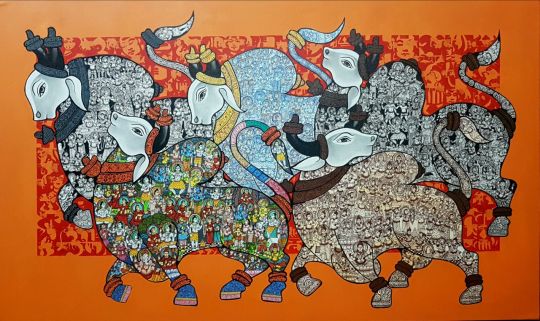Don't wanna be here? Send us removal request.
Text
The 5 Most Famous Paintings in the World
Hailing from a community in India, Vivek centers his fine art around the symbol of the grand Indian Bull. Conceived in 1977, Vivek Kumavat Paintings did his graduation in Fine Arts from the renowned Sir JJ School of Art, Mumbai and is presently based out of Mumbai. The Bull holds a noteworthy spot in Indian folklore as the 'vahana' or the vehicle of Lord Shiva and is a favorable symbol as a watchman god and an image of truth and equity. The type of the bull in Vivek's works of art demonstrates control and tremendous quality, while the appearances have a delicate mien radiating a quiet and patient emanation. He clarifies, "'I have seen that a bull is warm, delicate, energetic and benevolent creature, until it is incited to be savage; calm like human mentality in the general public." Interestingly, even in Indian folklore the Nandi is a human figure, half man-half bull, a blend of solidarity and reasonableness.

The superb Indian Bull remains as a similitude for human perseverance, both physical and mental. Vivek accepts that it is the attractive structure of a bull which pulls in positive emanations and energies in the spaces it is kept.
Craftsmanship. Comes in numerous structures, however painting has guaranteed a ton of acclaim and acknowledgment throughout the years. When somebody says they're a craftsman, you normally imagine them as a painter first. This is on the grounds that work of art as a fine art has been around for over 30,000 years, going back to the primary artworks that presently dwell in Grotte Chauvet, France.
These first artistic creations were engraved and painted utilizing red ochre and dark shade; they displayed steeds, rhinoceros, lions, wild oxen, mammoths, many unique plans, and fractional human figures.
Nonetheless, the most punctual proof of painting existing as a fine art was really found in two shake shields in Arnhem Land, or Northern Australia. Archeologists discovered utilized bits of ochre evaluated to be 60,000 years of age!
What's more, from that point forward, painting has progressed significantly. Presently we have countless (painting) craftsmen on Earth. Also, numerous unfathomably wonderful, and surely understood pieces. Which carries us to this article: The 5 Most Famous Paintings in the World. These gems are asserted as works of art and are completely unapproachable (truly).
So right away, how about we get into these fiercely well known artistic creations, and the motivation behind them!
The 5 Most Famous Paintings in the World
'Mona Lisa'— Leonardo da Vinci
While the right request of these canvases could be contended, this one notwithstanding, can't. The Mona Lisa is a work of art. A work of art all know about. One that can sit serenely at the highest priority on this rundown, with no contention.
The Mona Lisa is an extraordinarily excellent painting of a ladies named Lisa Gerardini, who dwelled in Florence, Italy. There was a silk broker in Florence named Francesco del Giocondo who demanded an artistic creation of his significant other.
The word Mona is a constriction of the Italian word "madonna," which originates from "mia donna" (which actually signifies "my lady" or "my woman"). This is the reason the work of art is called Mona Lisa, signifying "My Lady Lisa" after the ladies he painted it for.
The Mona Lisa has said for a long time to be of Francesco's significant other, despite the fact that while investigating I found there might be some discussion over his genuine dream. Maybe a mystery darling?
'Starry Night'— Vincent Van Gogh
"Toward the beginning of today I saw the wide open from my window quite a while before dawn, with only the morning star, which looked exceptionally enormous,"— Van Gogh to his sibling Theo, in a letter he composed admitting his motivation for Starry Night.
The window that he was depicting to his sibling sits inside a haven in Saint-Rémy, of Southern France. Here, Van Gogh was looking for enthusiastic help while as yet seeking after his fine art.
While Starry Night depends on scene and perception, it is likewise founded vigorously individually feelings, recollections, and creative mind. How about we separate it. The steeple of the congregation, is said to look like those in Holland, where he is from. Instead of the ones in France, where he was at the season of the work of art. The spinning movements in the sky are perceptions of residue, and gas, known as nebulae. These cosmic perceptions coordinated distributed records of the sky during that time. The work of art is very much organized, yet the short and substantial brush strokes make a "moving" piece. The rich and differentiating hues speak to Van Gogh's affection for the evening, which to him was, "considerably more alive and lavishly shaded than the day."
1 note
·
View note